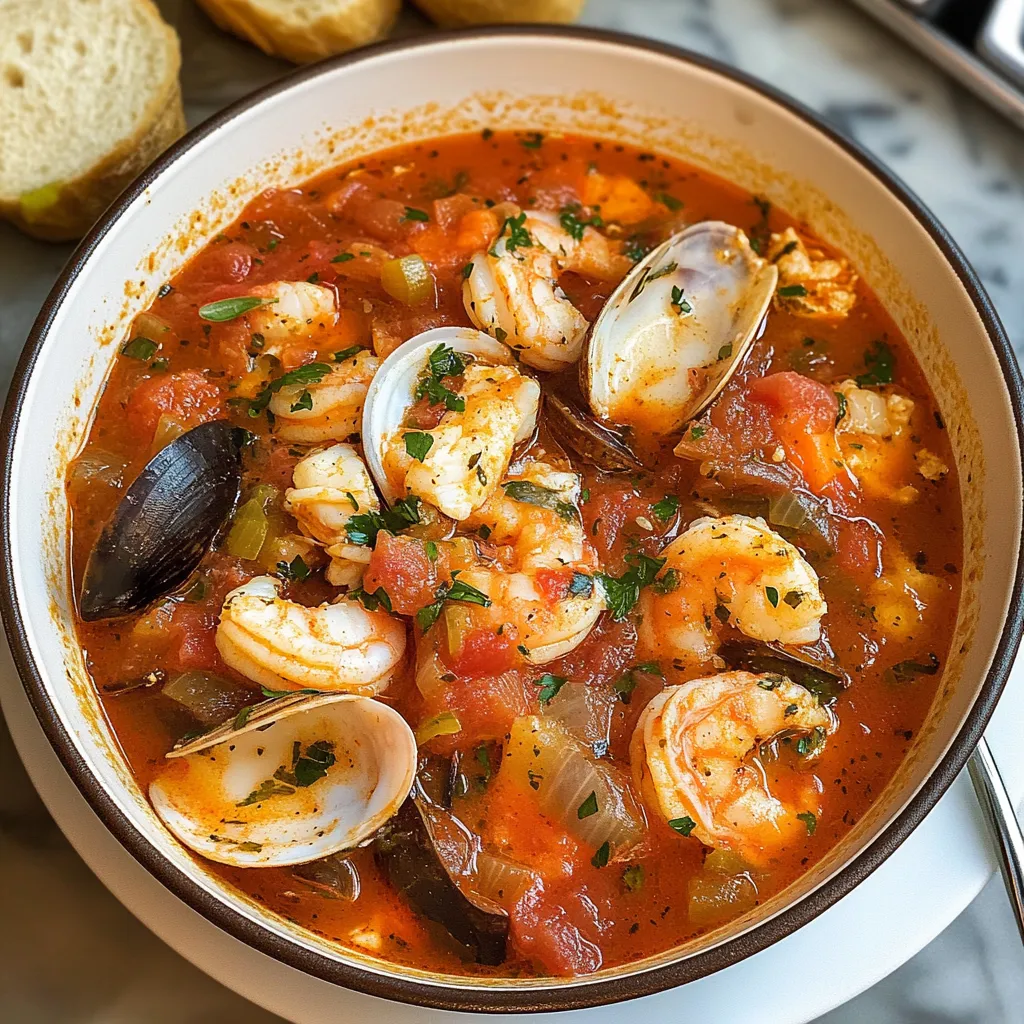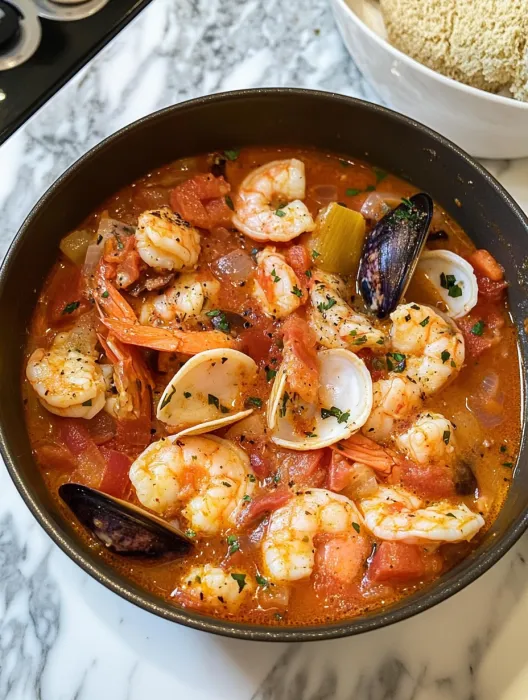 Save
Save
This hearty cioppino has been my go-to seafood stew for impressing dinner guests without spending hours in the kitchen. The rich tomato broth creates the perfect backdrop for tender seafood, while crusty bread on the side makes for the ultimate comfort meal.
I first made this cioppino during a weekend getaway at a beach cottage. The local seafood market inspired me to recreate this San Francisco classic, and now it has become our tradition whenever we want to make an ordinary evening feel special.
Ingredients
- Unsalted butter creates a rich foundation for the stew look for European style butter for extra richness
- Sweet onion and fennel provide aromatic sweetness that complements seafood perfectly
- Tomato paste adds concentrated umami flavor make sure to cook it until it darkens slightly
- Fresh garlic cloves bring essential flavor use freshly minced rather than jarred for best results
- Dried oregano and red pepper flakes add Italian inspired warmth adjust pepper to your heat preference
- Dry white wine provides acidity and depth choose something you would drink like Sauvignon Blanc or Pinot Grigio
- Petite diced tomatoes create the perfect texture for the broth regular diced works too but petite offers better distribution
- Vegetable stock and clam juice form the base of the broth the clam juice is essential for authentic seafood flavor
- Bay leaf adds subtle herbal notes that tie everything together
- Little neck clams and mussels should be tightly closed when raw indicating freshness
- Cod or halibut brings substantial meaty texture to the stew look for thick fresh fillets
- Shrimp and scallops add sweetness and different textural elements for variety
- Fresh parsley brightens the entire dish at the end use flat leaf rather than curly for better flavor
Step-by-Step Instructions
- Build the Aromatic Base
- Melt butter in a Dutch oven over medium high heat until foaming subsides. Add diced onion and fennel, cooking with occasional stirring for about 8 minutes until they become translucent and slightly caramelized around the edges. This aromatic foundation will infuse the entire broth with subtle sweetness.
- Develop the Flavor Base
- Add tomato paste, minced garlic, oregano and red pepper flakes to the pot, stirring constantly for about 1 minute. The tomato paste should darken slightly and stick to the bottom of the pan a bit. This brief cooking concentrates flavors and removes any raw taste from the garlic and spices.
- Create the Broth
- Pour in the wine and use a wooden spoon to scrape up any browned bits from the bottom of the pot. Add diced tomatoes, vegetable stock, clam juice and bay leaf. Bring everything to a boil, then reduce heat to maintain a gentle simmer for 15 minutes uncovered. This allows the flavors to meld together and the broth to reduce slightly, intensifying the taste. Season with salt and pepper to your preference.
- Cook the Shellfish
- Add clams and mussels to the simmering broth. Reduce heat to low, cover the pot with a tight fitting lid, and cook for 3-4 minutes. During this time, the shellfish will begin to open as they cook in the fragrant liquid. The tight lid creates steam that helps them open properly.
- Add Remaining Seafood
- Gently add the cod or halibut pieces, shrimp, and scallops to the pot. Continue simmering with the lid on for another 3-4 minutes until the fish is opaque, the shrimp are pink and curled, and the scallops are firm but tender. The clams and mussels should be completely open by now. Discard any shellfish that remain closed as they are not safe to eat.
- Finish and Serve
- Remove the pot from heat and stir in fresh parsley. Taste once more and adjust salt and pepper if needed. Ladle the cioppino into wide, shallow bowls making sure each serving gets a good variety of seafood. Serve immediately while piping hot with crusty bread for dipping into the flavorful broth.

Fennel is my secret ingredient in this recipe. While some people think they don't like its subtle anise flavor, once it cooks down in the broth, it adds a mysterious sweetness that everyone loves without being able to identify exactly what makes the stew so special. My Italian grandmother would never make cioppino without it.
Seafood Selection Tips
Freshness is absolutely crucial when making cioppino. Look for seafood that smells clean and oceany, never fishy. For shellfish, the shells should be tightly closed when raw or close when tapped if theyre slightly open. If buying frozen seafood, thaw it slowly in the refrigerator overnight rather than using quick thawing methods which can compromise texture.
Make It Ahead
While the final seafood cooking should happen just before serving, you can prepare the base broth up to two days ahead. Make the recipe through the broth simmering stage, cool completely, then refrigerate. When ready to serve, bring the broth back to a simmer before adding seafood. This actually improves the flavor as the broth ingredients have more time to meld together.
Serving Suggestions
Cioppino demands good bread for sopping up the amazing broth. A crusty sourdough loaf is traditional in San Francisco, but any artisan bread with a firm crust and chewy interior works beautifully. Serve with a simple green salad dressed with lemon vinaigrette to cut through the richness of the stew. For wine pairing, the same dry white wine used in cooking is perfect, or try a light bodied Pinot Noir if you prefer red.

Recipe FAQs
- → What's the best type of wine to use for cioppino?
A dry white wine like Sauvignon Blanc, Pinot Grigio, or unoaked Chardonnay works best for cioppino. These wines add acidity and brightness without overwhelming the seafood flavors. Always choose a wine you'd enjoy drinking, as the quality will impact the final taste of your stew.
- → Can I make cioppino in advance?
You can prepare the broth up to 2 days ahead and refrigerate it. When ready to serve, reheat the broth to a simmer and then add the seafood in stages as directed. This makes entertaining easier while ensuring the seafood remains tender and perfectly cooked.
- → What can I substitute if I can't find clam juice?
If clam juice isn't available, you can use additional vegetable stock, seafood stock, or even chicken broth as a substitute. For added seafood flavor, consider dissolving a seafood bouillon cube in warm water or using the liquid from canned clams.
- → How do I know when the seafood is properly cooked?
Shellfish like clams and mussels are done when their shells open wide (discard any that remain closed). Fish like cod should be opaque and flake easily. Shrimp turn pink and slightly curved, while scallops become opaque and firm but still tender when properly cooked. Be careful not to overcook seafood as it can become tough and rubbery.
- → What's the best way to serve cioppino?
Serve cioppino in large, shallow bowls to showcase the beautiful seafood. Accompany with crusty sourdough bread or garlic bread for soaking up the flavorful broth. Provide extra bowls for discarded shells, lemon wedges for brightness, and a sprinkle of fresh herbs like parsley or basil. A glass of the same white wine used in cooking makes a perfect pairing.
- → Can I use frozen seafood for this stew?
Yes, frozen seafood can work well in cioppino. Thaw completely before adding to the stew and adjust cooking times slightly as needed. While fresh seafood provides optimal flavor and texture, high-quality frozen alternatives make this dish accessible year-round and often more economical.
